Related Research Articles

An electronic calculator is typically a portable electronic device used to perform calculations, ranging from basic arithmetic to complex mathematics.

The slide rule is a mechanical analog computer. The slide rule is used primarily for multiplication and division and for functions such as exponents, roots, logarithms, and trigonometry. They are not designed for addition or subtraction which was usually performed manually, with scientific notation used to keep track of the magnitude of results. Maximum accuracy for standard linear slide rules was about three decimal digits.

The Sinclair ZX80 is a home computer launched on 29 January 1980 by Science of Cambridge Ltd.. It is notable for being one of the first computers available in the United Kingdom for less than a hundred pounds. It was available in kit form for £79.95, where purchasers had to assemble and solder it together, and as a ready-built version at £99.95. The ZX80 was very popular straight away, and for some time there was a waiting list of several months for either version of the machine.
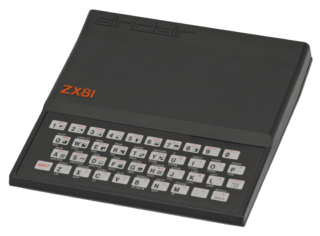
The ZX81 is a home computer that was produced by Sinclair Research and manufactured in Dundee, Scotland, by Timex Corporation. It was launched in the United Kingdom in March 1981 as the successor to Sinclair's ZX80 and designed to be a low-cost introduction to home computing for the general public. It was hugely successful; more than 1.5 million units were sold. In the United States it was initially sold as the ZX-81 under licence by Timex. Timex later produced its own versions of the ZX81: the Timex Sinclair 1000 and Timex Sinclair 1500. Unauthorized ZX81 clones were produced in several countries.
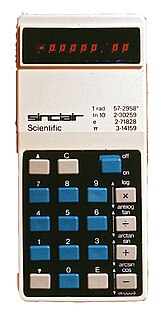
The Sinclair Scientific calculator was a 12-function, pocket-sized scientific calculator introduced in 1974, dramatically undercutting in price other calculators available at the time. The Sinclair Scientific Programmable, released a year later, was advertised as the first budget programmable calculator.
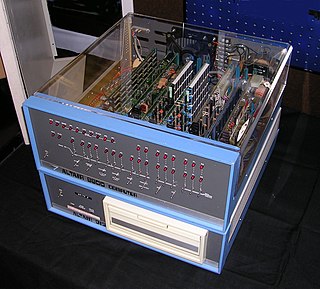
The Altair 8800 is a microcomputer designed in 1974 by MITS and based on the Intel 8080 CPU. Interest grew quickly after it was featured on the cover of the January 1975 issue of Popular Electronics and was sold by mail order through advertisements there, in Radio-Electronics, and in other hobbyist magazines. The Altair is widely recognized as the spark that ignited the microcomputer revolution as the first commercially successful personal computer. The computer bus designed for the Altair was to become a de facto standard in the form of the S-100 bus, and the first programming language for the machine was Microsoft's founding product, Altair BASIC.
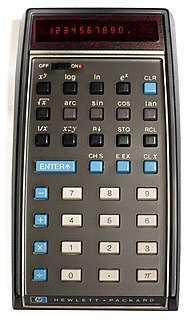
The HP-35 was Hewlett-Packard's first pocket calculator and the world's first scientific pocket calculator: a calculator with trigonometric and exponential functions. It was introduced in 1972.

A membrane keyboard is a computer keyboard whose "keys" are not separate, moving parts, as with the majority of other keyboards, but rather are pressure pads that have only outlines and symbols printed on a flat, flexible surface. Very little, if any, tactile feedback is felt when using such a keyboard.
Microsoft has designed and sold a variety of ergonomic keyboards for computers. The oldest is the Microsoft Natural Keyboard, released in 1994, the company's first computer keyboard. The newest models are the Sculpt ergonomic keyboard (2013) the Surface Ergonomic Keyboard (2016) and the Microsoft Ergonomic Keyboard (2019).
Micro Instrumentation and Telemetry Systems (MITS) was an American electronics company founded in Albuquerque, New Mexico that began manufacturing electronic calculators in 1971 and personal computers in 1975.
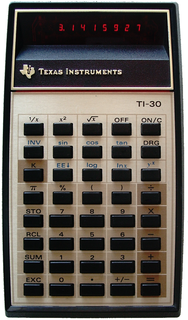
The TI-30 is a scientific calculator manufactured by Texas Instruments, the first model of which was introduced in 1976. While the original TI-30 was discontinued in 1983 after several design revisions, TI maintains the TI-30 designation as a branding for its low and mid-range scientific calculators.
Sinclair Radionics Ltd was a company founded by Sir Clive Sinclair in Cambridge, England which developed hi-fi products, radios, calculators and scientific instruments.

Christopher Curry is the co-founder of Acorn Computers, with Hermann Hauser and Andy Hopper. He became a millionaire as a result of Acorn's success.
Sinclair Research Ltd is a British consumer electronics company founded by Clive Sinclair in Cambridge. It was originally incorporated in 1973 as Westminster Mail Order Ltd, renamed Sinclair Instrument Ltd, then Science of Cambridge Ltd, then Sinclair Computers Ltd, and finally Sinclair Research Ltd. It remained dormant until 1976, when it was activated with the intention of continuing Sinclair's commercial work from his earlier company Sinclair Radionics, and adopted the name Sinclair Research in 1981.
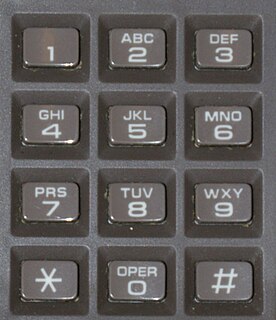
A keypad is a block or pad of buttons set with an arrangement of digits, symbols, or alphabetical letters. Pads mostly containing numbers and used with computers are numeric keypads. Keypads are found on devices which require mainly numeric input such as calculators, television remotes, push-button telephones, vending machines, ATMs, Point of Sale devices, combination locks, and digital door locks. Many devices follow the E.161 standard for their arrangement.

The Sinclair Sovereign was a high-end calculator introduced by Clive Sinclair's company Sinclair Radionics in 1976. It was an attempt to escape from the unprofitable low end of the market, and one of the last calculators Sinclair produced. Made with a case of pressed steel that a variety of finishes, it cost between GB£30 and GB£60 at a time when other calculators could be purchased for under GB£5. A number of factors meant that the Sovereign was not a commercial success, including the cost, high import levies on components, competition from cheaper calculators manufactured abroad, and the development of more power-efficient designs using liquid-crystal displays. Though it came with a five-year guarantee, issues such as short battery life limited its usefulness. The company moved on to producing computers soon afterwards.

The Sinclair Cambridge was a pocket-sized calculator introduced in August 1973 by Sinclair Radionics. It was available both as kit form kit to be assembled by the purchaser, or assembled prior to purchase. The range ultimately comprised seven models, the original "four-function" Cambridge, which carried out the four basic mathematical functions of addition, subtraction, multiplication, and division, being followed by the Cambridge Scientific, Cambridge Memory, two versions of Cambridge Memory %, Cambridge Scientific Programmable and Cambridge Universal.

The history of the personal computer as a mass-market consumer electronic device began with the microcomputer revolution of the 1970s. A personal computer is one intended for interactive individual use, as opposed to a mainframe computer where the end user's requests are filtered through operating staff, or a time-sharing system in which one large processor is shared by many individuals. After the development of the microprocessor, individual personal computers were low enough in cost that they eventually became affordable consumer goods. Early personal computers – generally called microcomputers – were sold often in electronic kit form and in limited numbers, and were of interest mostly to hobbyists and technicians.

A computer keyboard is a peripheral input device modeled after the typewriter keyboard which uses an arrangement of buttons or keys to act as mechanical levers or electronic switches. Replacing early punched cards and paper tape technology, interaction via teleprinter-style keyboards have been the main input method for computers since the 1970s, supplemented by the computer mouse since the 1980s.

A keyboard layout is any specific physical, visual or functional arrangement of the keys, legends, or key-meaning associations (respectively) of a computer keyboard, mobile phone, or other computer-controlled typographic keyboard.
References
- 1 2 "Sinclair Wrist Calculator". vintagecalculators.com. Retrieved 26 January 2014.
- 1 2 "Sinclair Wrist Calculator". Planet Sinclair. Retrieved 26 January 2014.
- ↑ "International Design". 52 (5–8): 105.Cite journal requires
|journal=(help) - 1 2 "Unique full-function 8-digit wrist calculator... available only as a kit". Popular Mechanics: 195. April 1977.